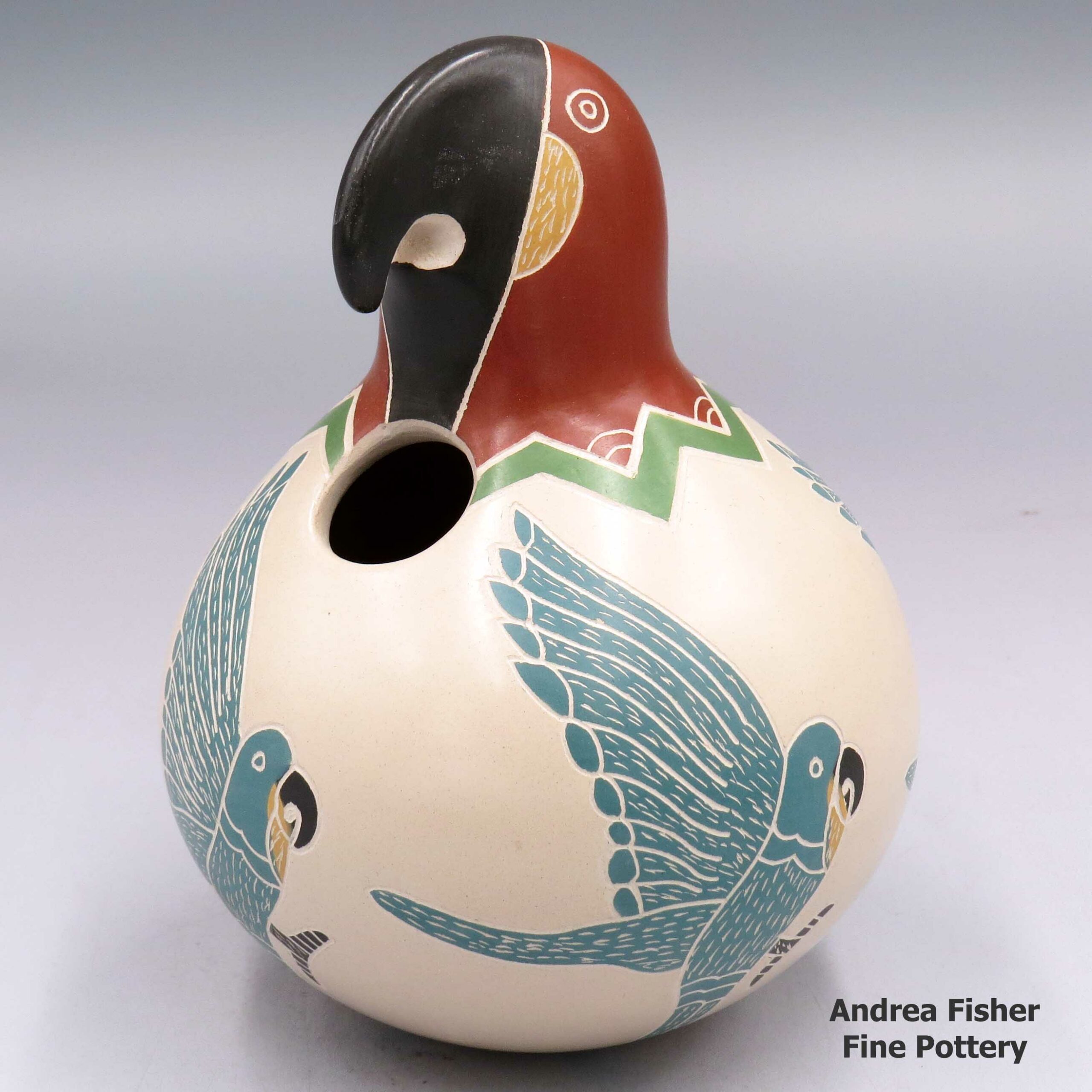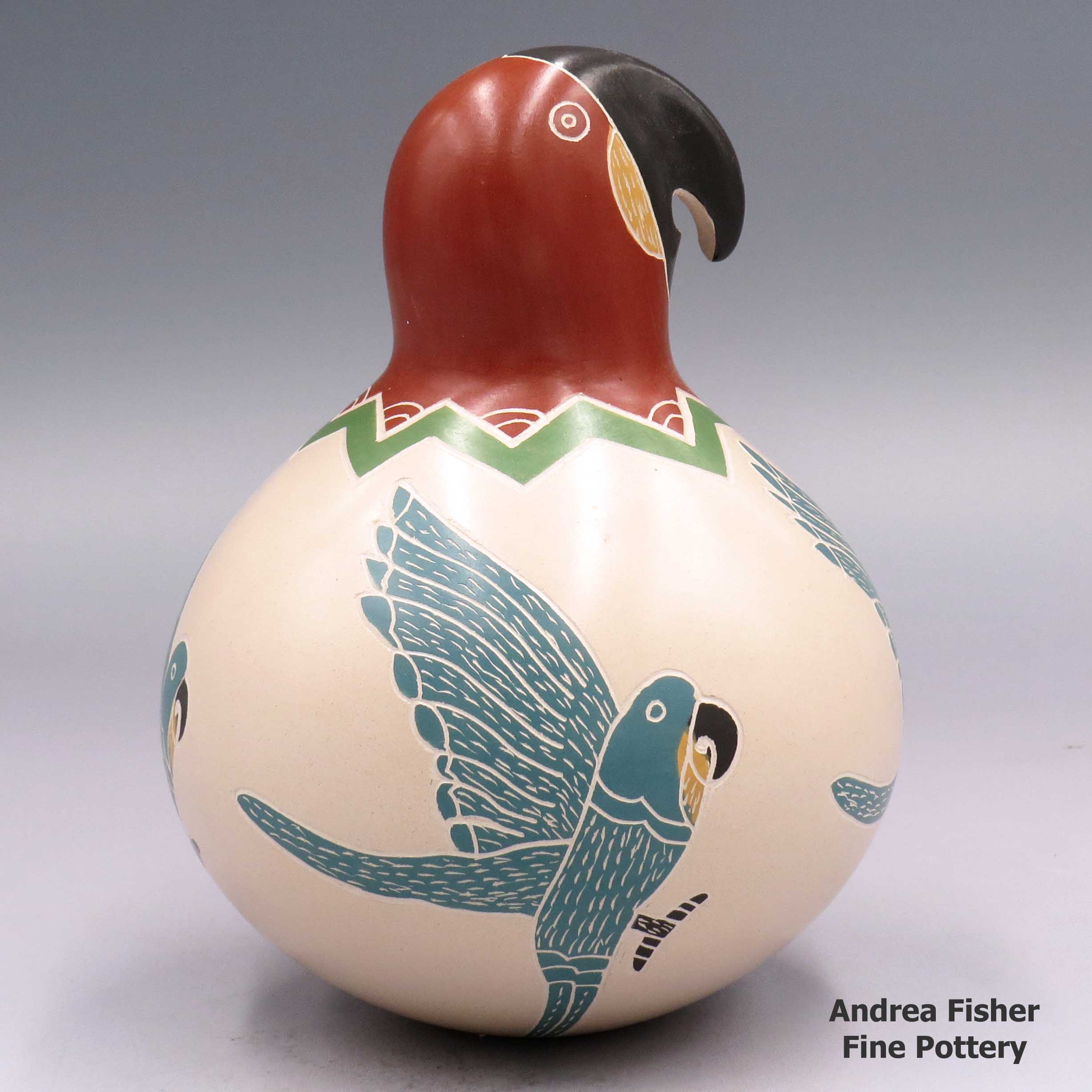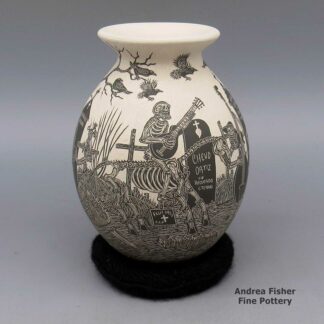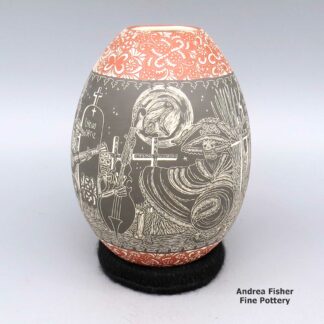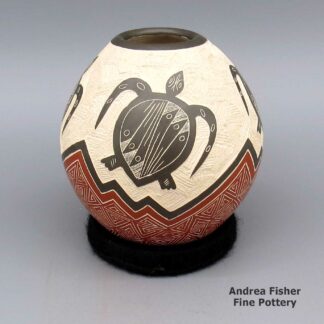| Dimensions | 4.75 × 4.75 × 6.25 in |
|---|---|
| Date Born | 2021 |
| Condition of Piece | Excellent |
| Signature | Vidal Corona |
Vidal Corona, aqcg1h557, Polychrome parrot effigy jar with 4-panel parrot design
$295.00
A polychrome parrot effigy jar with a sgraffito-and-painted 4-panel parrot design
In stock
- Product Info
- About the Artist
- Home Village
- Design Source
- About the Shape
- About the Design
- Family Tree
Brand
Corona, Vidal
Vidal's signature pieces these days often offer uniquely expressive avian forms sculpted into the openings of his vessels. He then etches large and small designs into the surface of the clay, paints them in colors that match the theme of the pot and then fires them to produce his finished product. Many of his designs revolve around macaws, parrots, eagles and other birds, and butterflies.
His sister, Angela Corona, credits Vidal with teaching her how to make pottery and she has become successful in her own right, developing a distinctive series of polychrome owl effigy jars and lizard-covered seed pots.
About Mata Ortiz and Casas Grandes
Mata Ortiz is a small settlement inside the bounds of the Casas Grandes municipality, very near the site of Paquimé. The fortunes of the town have gone up and down over the years with a real economic slump happening after the local railroad repair yard was relocated to Nuevo Casas Grandes in the early 1960s. It was a village with a past and little future.
A problem around the ancient sites has been the looting of ancient pottery. From the 1950s on, someone could dig up an old pot, clean it up a bit and sell it to an American dealer (and those were everywhere) for more money than they'd make in a month with a regular job. And there's always been a shortage of regular jobs.
Many of the earliest potters in Mata Ortiz began learning to make pots when it started getting harder to find true ancient pots. So their first experiments turned out crude pottery but with a little work, their pots could be "antiqued" enough to pass muster as being ancient. Over a few years each modern potter got better and better until finally, their work could hardly be distinguished from the truly ancient. Then the Mexican Antiquities Act was passed and terror struck: because the old and the new could not be differentiated, potters were having all their property seized and their families put out of their homes because of "antiqued" pottery they made just yesterday. Things had to change almost overnight and several potters destroyed large amounts of their own inventory because it looked "antique." Then they went about rebooting the process and the product in Mata Ortiz.
For more info:
Mata Ortiz pottery at Wikipedia
Mata Ortiz at Wikipedia
Casas Grandes at Wikipedia
Contemporary Pottery
The term "contemporary" has several possible shadings in reference to Southwestern pottery. At some pueblos, it's more an indicator of a modern style of carving or etching than anything else. At San Felipe it refers to almost anything newly made there as they have almost no prehistoric templates to work from. At Jemez the situation resolved to where what makes a piece uniquely "Jemez" is the clay. Any designs on that clay can be said to be "contemporary."
About Effigies
An effigy is a sculpture or model of an animal or person. Effigies have a long history among southwestern Native Americans. Effigies include everything from pottery that explicitly resembles a human or an actual animal to pottery that only references a part or parts of a human or an animal in its shape to creations of creatures that are absolutely wild and whimsical.
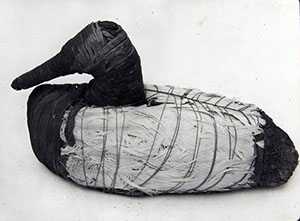
In Nevada, near the Humboldt Sink (where the Humboldt River disappears into the desert sands), a group of guano miners working in Lovelock Cave in 1911 exposed some ancient artifacts while they were digging. Shortly after the miners left, some archaeologists arrived and started poking around and digging, too. They weren't much better educated in the practices of archaeological digging than the guano miners were but they did save almost everything they found. It was more than a decade after those archaeologists investigated the cave that other archaeologists dug a bit deeper in the back of the cave and found a bundle of eleven duck decoys, all woven of local reeds more than 2,300 years ago. Some were painted, some were decorated with feathers, some weren't finished yet.
Effigies have been found in Mayan ruins, Aztec ruins, the ruins of Teotihuacan, the ruins near Valdivia in Ecuador, the ruins of the pyramid-building cultures in Peru and ruins near the Caribbean coast in Colombia. There were many effigies found in the ruins of Paquimé, too.
Photo of the duck decoy courtesy of the Autry Museum, CCA-by-SA 3.0 License.
About Wildlife and Nature Designs
What we're calling "wildlife and nature designs" are usually quite contemporary designs carved, painted and/or etched by hand on a hand-made piece of pottery. In the same genre are bird, butterfly, dragonfly, moth, bat and fish designs. Some have seaweed and vines, some have trunks and branches, some have leaves and/or flowers and/or berries, some don't. Some are composed of optical illusions while others are very clear to the eye. While the designs and layouts tend to be quite contemporary, sometimes they incorporate elements of ancient settings.
Juan Quezada Family and Teaching Tree - Mata Ortiz
Disclaimer: This "family and teaching tree" is a best effort on our part to determine who the potters are in this grouping and arrange them in a generational order/order of influence. Complicating this for Mata Ortiz is that everyone essentially teaches everyone else (including the neighbors), so it's hard to get a real lineage of family/teaching. The general information available is scant. This diagram is subject to change as we get better info.
- Juan Quezada Sr. (1940-2022) & Guillermina Olivas Reyes (1945-)
- Nicolas Quezada (1947-2011) & Maria Gloria Orozco
- Elida Quezada & Ramon Lopez
- Jose Quezada (1972-) & Marcela Herrera
- Leonel Quezada Talamontes (1977-2014)
- Reynaldo Quezada & Monserat Treviso
- Lucia Quezada
- Lupita Quezada & Hector Quintana
- Maria de los Angeles Quezada
- Maria Guadalupe Quezada
- Mariano Quezada Treviso & Rocio de Quezada
- Maria Acosta
- Fernando Andrew
- Octavio Andrew (1970-)
- Jose Cota
- Gloria Lopez
- Rosa Lopez
Rosa and Gloria's students:
- Roberto & Angela Banuelos
- Adriana Banuelos
- Diana Laura Banuelos
- Mauricio Banuelos
- Olga Quezada & Humberto Ledezma
- Roberto & Angela Banuelos
- Lydia Quezada & Rito Talavera
- Moroni Quezada (1993-)
- Pabla Quezada
- Consolacion Quezada & Guadalupe Corona Sr.
- Dora Quezada
- Guadalupe Lupe Corona Jr.
- Hilario Quezada Sr. & Matilde Olivas de Quezada
- Mauro Quezada (1968-) & Martha Martinez de Quezada
- Avelina Corona & Angel Amaya
- Mauro Corona
- Luis Baca & Carmen Fierro
- Avelina Corona & Angel Amaya
- Oscar Corona Quezada
- Octavio Gonzalez Camacho (Quezada)
- Oscar Gonzales Quezada Jr.
- Guadalupe Lupita Cota
- Reynalda Quezada & Simon Lopez
- Samuel Lopez Quezada (1972-) & Estella S. de Lopez
- Olivia Lopez Quezada & Hector Ortega
- Yolanda Lopez Quezada
- Rosa Quezada
- Noelia Hernandez Quezada (1975-)
- Paty Quezada
- Jesus Quezada
- Imelda Quezada
- Jaime Quezada
- Jose Luis Quezada Camacho
- Mary Quezada
- Genoveva Quezada & Damian Escarcega
- Damian Quezada & Elvira Antillon
- Anjelica Escarcega
- Ana Trillo
- Yesenia Escarcega
- Ivona Quezada
- Miguel Quezada
- Damian Quezada & Elvira Antillon
- Alvaro Quezada
- Arturo Quezada
- Efren Quezada
- Juan Quezada Jr. & Lourdes Luli Quintana de Quezada
- Laura Quezada
- Maria Elena Nena Quezada de Lujan
- Alondra Lujan Quezada
- Mireya Quezada
- Noe Quezada & Betty Quintana de Quezada
- Guillermina Quezada Quintana
- Ivan Quezada Quintana
- Lupita Quezada Quintana
- Taurina Baca (1961-)
- Gerardo Cota
- Guadalupe Gallegos
- Ivonne Olivas
- Manuel Manolo Rodriguez Guillen (1972-)
